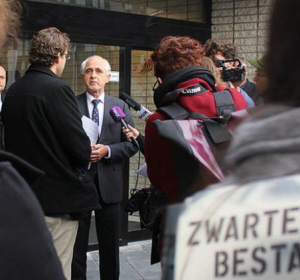University of Utrecht, where human rights are purely academic and not functional

The University of Utrecht has its own academic section for human rights research and expertise: it is called the Netherlands Institute of Human Rights (SIM) and they host various workshops, lectures, and seminars. In 2016, this human rights section hosted the AHRI conference. You might expect that an academic institution that believes in human rights would believe in applying them themselves, but the University of Utrecht has failed to uphold the rights of its own students, including exchange students, and the rights of the citizens and visitors to Utrecht. The university annually sponsors a racist parade in the centre of Utrecht, featuring people in blackface (face paint applied to mimic a black African). This violates the dignity of black people. The university should be anti-racism because the right not to be racially discriminated is a human right, after all.
| Deze tekst in het Nederlands |
There have been plenty of reasons to stop sponsoring this racist parade, plenty of moments when the university could have reflected on its responsibilities, because this issue, being a high profile one, has lead to the blackfacing phenomenon as been labelled discriminatory by both the Dutch Children’s Ombudswoman and another Netherlands Institute of Human Rights (same name, different organisation) which deals with equal opportunities legislation. The caricatural figure being portrayed is one which promotes stereotypes. In 1998 two students, Scotty Gravenberch and Lulu Helder, wrote a book explaining the racism behind the figure, within its historical context and giving first hand accounts of how this discrimination impacts black people. The book contained a foreword by Philomena Essed, who is an eminent academic on the subject of Dutch racism.
Notable academics have or have had ties to Utrecht University and have also plighted for the banning of this racist phenomenon in the celebrations: Gloria Wekker, Patricia Schor, Quinsy Gario and Jenny Goldschmidt. In 2014, Jenny Goldschmidt published a speech called “Whose business is it anyway?” in which she wrote: “National human rights institutions have a great responsibility here.” But should we have to wait for the state to apply human rights, when we can begin with that ourselves?
There is an assistent professor at the University of Utrecht called Alexandra Timmer. She has written on the subject of stereotyping as being a human rights issue. Timmer wrote “that stereotypes are both cause and manifestation of the structural disadvantage and discrimination of certain groups of people”, and this certainly applies to the situation in the Netherlands, beginning with the racist parade. The stereotyping that takes place every Sinterklaas season (a few weeks from November to the 5th of December) is ubiquitous. One doesn’t need to look elsewhere in Europe, to the treatment of Roma or Sinti, to see the discriminatory effects of stereotyping. It happens in the Netherlands too, on a grand scale.
The university is wilfully blind to the racist stereotyping that it sponsors. Students have presented petitions to the university, protesting for example in 2014, but the university said that although they were against racism, they saw “no reason” to change their policy. Words that don’t match their deeds. In 2016, there were still racist caricatures donning black face-paint during the parade in Utrecht. The racist caricatures were accompanied by other supposedly neutral figures, painted to look as if there were merely smatterings of soot on their faces, but under those smatterings of soot, the actors wore dark foundation to make it seem as if their skin colour was dark anyway!
A couple of years ago I came across a horrified message from an exchange student studying at this university. It made her feel really uncomfortable to see models of these caricatures decorating the university dining areas. Consequently the contactperson responsible for exchange students arriving from the University of East London contacted the University of Utrecht. He was unable to change the mind of the executive board of the university. The student was told that it’s a sensitive issue. It’s an indictment of the pervasive racism within Dutch society that the university ignores its own students, academics, national human rights institutions and visiting students, and continue to sponsoring the racist parade, known as the “Sinterklaasintocht” in Utrecht.
JvL
